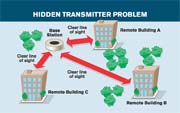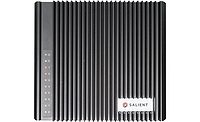The 802.11 standard is constantly improving to meet the challenges of data, voice and even video networking. There are currently over eight IEEE (Institute of Electrical and Electronics Engineers) committees
and subcommittees developing various enhancements to the standard on subjects as diverse as HDTV (high definition TV) wireless streaming in the home, security of wireless links, harmonization of the standard with the European Hyperlan WLAN technology and improvements of the QOS (quality of service) for audio and video streaming. Despite these changes, the WLAN standard was primarily designed for indoor use within a home or office environment, not for outdoor operation. It is nonetheless very attractive to use this technology outdoors. Since it is very low cost, there are plenty of vendors offering standard compliant products, and the data throughput is much better than the data pipes offered by telcos, cable and cellular operators. Unfortunately, there are problems associated with using the 802.11 technology outdoors.

The Hidden Node Problem
The IEEE 802.11 standard for wireless LANs was designed to extend wired Ethernet practices to a wireless local area network. Because they were designed for local area networks, these network protocols function much like wired Ethernet. If a station has a packet to send, it first listens to see if another station is busy transmitting, and then transmits its packet. This assumes, of course, that the transmitting station is able to hear other stations on the network.A common problem which occurs when 802.11 compliant equipment is used outdoors is the “hidden node” problem. This problem occurs when a wireless node cannot hear one or more of the other nodes, therefore the media access protocol cannot function properly. When this happens, multiple nodes will attempt to transmit their data over the shared medium simultaneously, causing signal interference with one another. Much like a broadcast storm on a wired LAN segment can bring traffic to a standstill, hidden transmitter nodes interfering with one another will have a very detrimental effect on the performance of every wireless node in the network. This interference can cause overall performance of the entire wireless network to drop by as much as 50 percent. When using streaming video this number can easily increase to 70 percent due to the continuous nature of the transmission.
The 802.11b standard only addresses the hidden transmitter problem using a media access protocol called CSMA/CA (carrier sense multiple access/collision avoidance) and special packets called request to send (RTS), clear to send (CTS), and acknowledge (ACK). 802.11b uses these special packets to alert every node on the network that a transmission node has data to send, that a transmission is about to take place, and that the transmission has ended by broadcasting the packets across the entire network. This time and bandwidth consuming process is required for each and every transmission by each and every wireless node. Unfortunately, it still doesn’t address the hidden transmitter problem because it is possible for more than one node to initiate this process at the same time because they cannot “hear” each other directly. In fact, at the 23rd annual conference on local computer networks, researchers from Colorado State University indicated, “Our simulations indicate that hidden terminals can have a very detrimental effect on the performance of the IEEE 802.11b MAC protocol.” In an indoor environment, the RTS/CTS mechanism along with CSMA/CA may be sufficient, but it is simply not suited for long-range, high-speed wireless communications between buildings. Extensive testing by SmartSight Networks R&D team has also demonstrated that the RTS/CTS mechanism is entirely inefficient when streaming video in an environment with hidden nodes. This is because the RTS/CTS protocol was developed for noncontinuous data transmission and does not respond fast enough for continuous data transmission.
The Fallback of 802.11b Interoperability
The 802.11b standard integrates a complex protocol for authentication of new devices on the wireless network and for roaming between stations. In addition, due to interoperability requirements, the radio preamble sent at the beginning of every 802.11 packet is sent at the lowest radio speed. For small packets, this preamble makes up a large percentage of the transmission time. As many small packets are sent to support roaming, authentication, acknowledgement of packets, etc., utilization drops to a fraction of what would be available if larger chunks of data were being transmitted.Since interoperability, high quality and low cost of 802.11b devices are strong incentives for using this technology in outdoor environments, several research organizations have studied ways to resolve the hidden node and effective bandwidth problems. One company, Karlnet Inc., has its TurboCell, which resolves the hidden node problem by centralizing control of the wireless network at the TurboCell access point or base station. The TurboCell access point uses a highly-optimized polling technique to tell remote wireless stations when they can transmit. To avoid problems associated with pure polling schemes, TurboCell also employs a “free for all” period to enable stations that have data available but are low in the polling queue to transmit without much delay. The “free for all” period allows a station that may not have transmitted for a long period of time to begin transmitting once again and move to a higher priority in the polling scheme. The determination of polling intervals based on a complex combination of factors is finely tuned and the result of years of research into wireless performance in production environments.
For performance-critical outdoor point-to-mulitpoint environments, optimal bandwidth usage is crucial. The TurboCell protocol remedies the effective bandwidth problems associated with roaming, authentication and long preamble by aggregating many small packets into a single SuperPacket for transmission over the wireless link.
SmartSight Networks, Ontario, Canada, has partnered with Karlnet Inc., to embed the Turbocell protocol in its S1000w wireless video transmitters. The company is also fine-tuning the technology for continuous high quality MPEG4 video streams.


